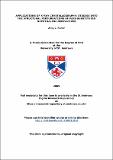Files in this item
Applications of X-ray crystallography: studies into the structural perturbations of peri-substituted naphthalene derivatives
Item metadata
| dc.contributor.advisor | Slawin, Alexandra M. Z. | |
| dc.contributor.advisor | Woollins, J. D. (J. Derek) | |
| dc.contributor.author | Fuller, Amy L. | |
| dc.coverage.spatial | 277 | en_US |
| dc.date.accessioned | 2009-12-09T15:54:16Z | |
| dc.date.available | 2009-12-09T15:54:16Z | |
| dc.date.issued | 2010-06 | |
| dc.identifier | uk.bl.ethos.552309 | |
| dc.identifier.uri | https://hdl.handle.net/10023/826 | |
| dc.description.abstract | The majority of research in this thesis uses X-ray crystallography to investigate the structural features of peri-substituted naphthalene compounds. X-ray crystallography is introduced in chapter one, followed by a discussion on modes of distortion peri-substituted naphthalene derivatives can undergo, in chapter two. In chapter three, compounds having non-bonded -SPh and -EPh (E = S, Se, or Te) peri-substituents are compared. These similar compounds react differently when oxidized with bromine. The oxidation products are used to discuss a recently proposed mechanism and a more specific mechanism is suggested. In chapter four, a one-pot synthesis for naphtho[1,8-c,d]-1,2-diselenole (Se₂naph) is reported. Substituents were added to Se₂naph to form two new naphthalene compounds. The substituents are found to distort the Se-Se bond and influence packing. In chapter five, several diselenium-containing compounds are used as ligands in platinum(II)-bisdiphosphine complexes. The preference for platinum(II) to stay square planar dictates the geometry around the metal center, not the rigidity of the naphthalene backbone. Chapter six introduces (8-phenylsulfanylnaphth-1-yl)diphenylphosphine, a peri-substituted naphthalene containing -SPh and -PPh₂ substituents, and several derivatives. This ligand is used in a variety of complexes containing platinum(II), ruthenium(II), and copper(I) metal halides, whose coordination geometries are discussed in chapter 7. The naphthalene-based ligands in Cu(I) and Ru(II) seem to determine the geometry around the metal, whereas the metal center d-orbitals dominate in the Pt(II) examples. Chapters eight and nine deviate from the naphthalene theme. In chapter eight, X-ray analysis of sulfoxide compounds is used to discuss the structural environment around the sulfur. Various intra- and inter-molecular interactions were discovered in crystal packing. Finally, chapter 9 uses STANDARD (St ANDrews Automated Robotic Diffractometer) to statistically analyze numerous E₂Ph₂ (E = S, Se, or Te) crystals to determine chirality. It is intriguing that Te₂Ph₂ shows a preference for one enantiomer over the other. | en_US |
| dc.language.iso | en | en_US |
| dc.publisher | University of St Andrews | |
| dc.subject | Naphthalene | en_US |
| dc.subject | Peri-substitution | en_US |
| dc.subject.lcc | QD945.F86 | |
| dc.subject.lcsh | X-ray crystallography--Scientific applications | en |
| dc.subject.lcsh | Naphthalene--Derivatives | en |
| dc.title | Applications of X-ray crystallography: studies into the structural perturbations of peri-substituted naphthalene derivatives | en_US |
| dc.type | Thesis | en_US |
| dc.type.qualificationlevel | Doctoral | en_US |
| dc.type.qualificationname | PhD Doctor of Philosophy | en_US |
| dc.publisher.institution | The University of St Andrews | en_US |
This item appears in the following Collection(s)
Items in the St Andrews Research Repository are protected by copyright, with all rights reserved, unless otherwise indicated.

